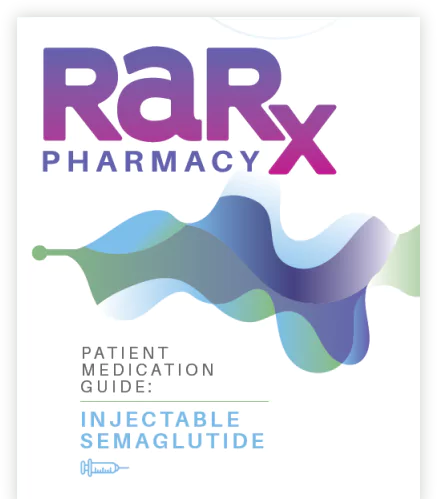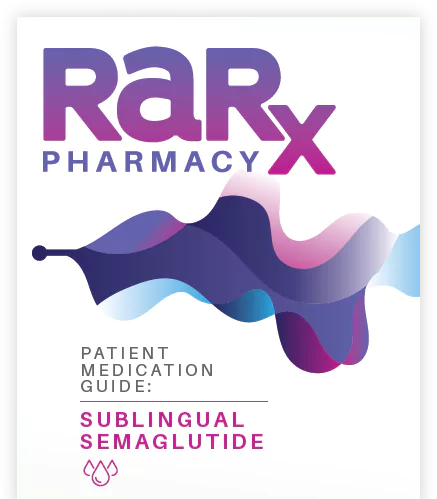About Semaglutide
Semaglutide and How it Works
Semaglutide is an extremely effective weight loss medication when combined with diet and exercise. In one study, patients achieved an average 34-pound weight loss*.
*Source: New England Journal of Medicine
Semaglutide targets the brain’s appetite control center to reduce food cravings, lowers blood glucose through its effects on insulin and glucagon, and promotes the sensation of “feeling full” by delaying gastric emptying.
Subcutaneous Injection
Semaglutide Subcutaneous Injection
Semaglutide Subcutaneous Injection is a custom compounded weight loss medication that is injected under the skin once a week.
Dose
Semaglutide is injected subcutaneously once a week. Preferred injection sites are the abdomen and thigh. The recommended initial dose is 0.25mg once a week for the first month. Typically, patients notice the onset of effects (a decrease in their appetite) within 5-10 days of starting therapy.
To minimize side effects, the dose is gradually increased over the first few months until the maintenance dose is reached. It may take as long as 4 to 5 weeks to reach the maximal effectiveness for a particular dose. Therefore, dose changes are not recommended in intervals of less than 4 weeks.
The final maintenance dose is determined clinically. It is the dose where the appetite is well controlled and side effects are minimal.
The final target dose is usually reached by the 4th or 5th month. In most patients, weight loss progresses at a safe and steady pace for 16 months before leveling off.
A typical dosing schedule is:
| Month | 1 | 2 | 3 | 4 | 5 and onward | 6 and onward |
| Dose | 0.25mg 10 units |
0.5mg 20 units |
0.75mg 30 units |
1.0mg 40 units |
1.7mg 68 units |
2.5mg 100 units |
| Start | Step Up | Step Up | Step Up | Target Maintenance or Step Up | Target Maintenance |
Kinetics
Semaglutide has a very long half-life due to its extensive binding to albumin which protects it from metabolic degradation. Elimination is from proteolysis and the breakdown components are excreted in the urine and feces. The elimination half-life is 7 days.
The duration of action once bound to the receptor is 64 hours.
The bioavailability of the subcutaneous dosage form is 89%.
Storage
Store the medication in the refrigerator (36°-46°F) and keep away from light. Leave it in the original vial until ready to inject. It is not recommended to draw up doses ahead of time.
Beyond Use Date (BUD)
The beyond use date is 180 days. Once a sterile vial has been punctured, it should be discarded after 28 days.
Sublingual Suspension
Semaglutide Sublingual Suspension
Semaglutide Sublingual Suspension is a custom compounded weight loss medication specially formulated to be taken under the tongue.
Our formulation combines Semaglutide with SubMagna™, an anhydrous base developed by PCCA that enhances drug absorption. SubMagna™ forms an emulsion that improves drug dispersion, optimizes contact time with the sublingual tissues and facilitates drug transport across the mucosa. The bioavailability of our sublingual formulation approaches that reached with injectable dosage forms.
Advantage of Sublingual Dosage form
Sublingual Semaglutide has some benefits over the subcutaneous injection and oral dosage forms. Our formulation maintains a substantial bioavailability without all of the disadvantages of an injection. In contrast to oral dosage forms, the sublingual route bypasses the GI tract and avoids destruction from stomach acid and digestion from gastric enzymes. It also avoids extensive drug deactivation from 1st pass hepatic metabolism.
- Avoids injection/needle-phobia anxiety
- No injection site reactions (pain, swelling, inflammation, bruising, infection)
- No refrigeration. Stored at room temperature
- Long beyond-use-dating (BUD = 90 days)
- Convenient once daily dosing
- Easy to administer, small volume oral syringes
- Pleasant taste
- Highly absorbed (bioavailability approaching injection)
- Better absorbed vs oral
- Avoids destruction and digestion in the stomach
- Avoids 1st pass hepatic metabolism
- Similar total dose vs injection
- Similar side effect profile as other dosage forms
- Cost savings
SubMagna™
Our formulation uses SubMagna™ as the sublingual vehicle.
- Sublingual anhydrous base that forms an emulsion when exposed to saliva, improving the solubility and dispersibility of drugs.
- Permeation-enhancing and unique mucoadhesive properties help drive molecules into mucosal tissue, potentially delivering greater drug absorption and increased contact time.
- Sublingual route of administration provides the opportunity to circumvent gastrointestinal factors that can influence the bioavailability.
- Offers the potential for longer beyond-use dates (BUDs)
- Developed to provide an alternative dosing delivery system for commercially available Semaglutide, and a broad range of other drugs.
To learn more about SubMagna™, visit: SubMagna™ HMW: Advanced Sublingual Drug Delivery Technology
Dose
The recommended initial sublingual dose approximates the subcutaneous injection dose. However, since the sublingual form is best absorbed in smaller volumes, the sublingual form is given daily. The daily dose is roughly calculated as 1/7th of the weekly subcutaneous dose.
Typically, patients notice the onset of effects (a decrease in their appetite) within 5-10 days of starting therapy. It may take as long as 4 to 5 weeks to reach the maximal effectiveness for a particular dose. Therefore, dose changes are not recommended in intervals of less than 4 weeks. It typically takes about 4 months of therapy to reach the final maintenance dose. In most patients, weight loss is steady for 16 months before leveling off.
A typical dosing schedule is:
Semaglutide 1mg/ml Sublingual Suspension
| Month | 1 | 2 | 3 | 4 and onward |
| Dose | 0.1ml | 0.2ml | 0.3ml | 0.4 |
| Start | Step Up | Step Up | Maintenance |
Kinetics
Semaglutide has a very long half-life due to its extensive binding to albumin which protects it from metabolic degradation. The duration of action once bound to the receptor is 64 hours. Elimination is from proteolysis and the breakdown components are excreted in the urine and feces. The elimination half-life is 7 days.
The bioavailability of the subcutaneous dosage form is 89%. The sublingual dosage form has not been adequately studied to assign a definitive bioavailability, but it is believed to approach that of the subcutaneous injection dosage form. The sublingual dosage form bypasses the gastric degradation and first-pass hepatic metabolism of the oral dosage form.
Storage
Store the medication at room temperature 60°-77°F (15°-25°C) and keep away from light. Leave it in its original vial and gently shake before drawing up the dose.
Beyond Use Date (BUD)
The beyond use date of this product is 90 days.
Sublingual Suspension Patient Guide
Important Safety Information
Semaglutide and How it Works
Semaglutide is an extremely effective weight loss medication when combined with diet and exercise. In one study, patients achieved an average 34-pound weight loss.
Semaglutide targets the brain’s appetite control center to reduce food cravings, lowers blood glucose through its effects on insulin and glucagon, and promotes the sensation of “feeling full” by delaying gastric emptying.
Indications and Usage
Semaglutide is indicated for weight loss in adults aged 18 to 75. Standard guidelines advocate initiation of therapy for obese and overweight patients.
- Obese: a body mass index (BMI) of 30kg/m2
- Overweight: BMI of 27kg/m2 with at least one weight-related condition (hypertension, type 2 diabetes, sleep apnea, and others).
Calculate BMI here.
Mechanism of Action
Semaglutide is a synthetic glucagon-like-peptide-1 receptor agonist (GLP-1 RA). It binds to the GLP-1 receptor in the brain that regulates appetite. It lowers blood glucose by increasing insulin release and reducing glucagon secretion. Gastric emptying is delayed which contributes to its blood glucose lowering effect and promotes the sensation of feeling full.
Contraindications
Do not use Semaglutide in patients with a personal or family history of medullary thyroid carcinoma (MTC), history of multiple endocrine neoplasia syndrome type 2 (MEN2) or Diabetic Ketoacidosis.
Common Side Effects / Adverse Reactions
Common side effects seen in patients taking Semaglutide include:
- abdominal discomfort
- heartburn
- constipation
- diarrhea
- nausea
- fatigue
- headache
Typically, side effects are more common when starting treatment and tend to become less prominent over time. Most side effects can be reduced by lowering the dose.
Patients are instructed to contact their doctor immediately if they experience:
- unusual swelling
- severe abdominal pain
- difficulty breathing
- signs of an allergic reaction
Not all the potential side effects are listed here.
Warnings and Precautions
- Risk of Thyroid C-Cell Tumors: Patients should be further evaluated if serum calcitonin is measured and found to be elevated or thyroid nodules are noted on physical examination or imaging
- Acute Pancreatitis: Acute pancreatitis has been observed in patients treated with GLP-1 receptor agonists, including Semaglutide.
- Acute Gallbladder Disease associated with an increased occurrence of cholelithiasis and cholecystitis. Substantial or rapid weight loss can increase the risk of cholelithiasis.
- Hypoglycemia: lowers blood glucose and can cause hypoglycemia.
- Hypersensitivity Reactions: Serious hypersensitivity reactions (e.g., anaphylaxis, angioedema) have been reported.
- Diabetic Retinopathy Complications in Patients with Type 2 Diabetes: Rapid improvement in glucose control has been associated with a temporary worsening of diabetic retinopathy.
Drug Interactions
Semaglutide causes a delay of gastric emptying, so it has the potential to alter the absorption of oral medications. Semaglutide lowers blood glucose, so the dose of diabetic medications, especially insulin, may need to be adjusted.
Use in Pregnancy / Breast Feeding
Semaglutide (or any other weight loss therapy) should not be used during pregnancy or while breast feeding. Discontinue Semaglutide at least 2 months before a planned pregnancy. The effects of Semaglutide on human milk and milk production is unknown.

